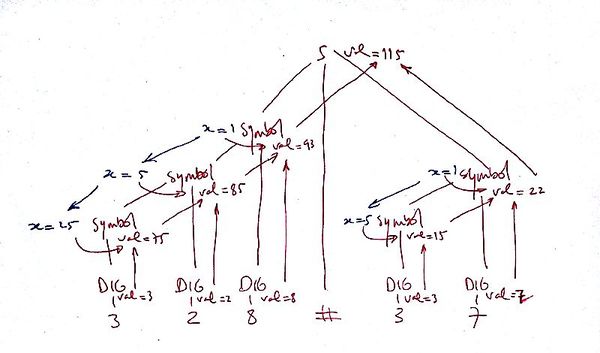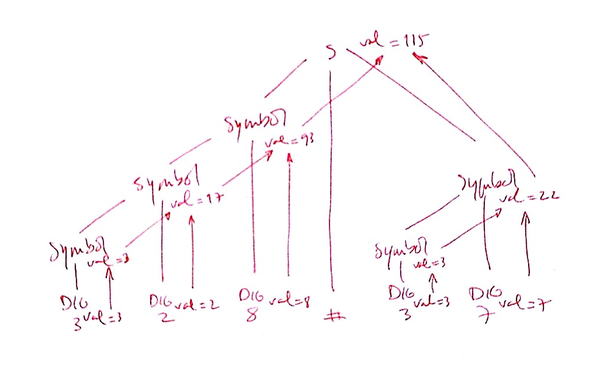Attribute Grammars/Exercise 2: Numbers: Difference between revisions
From Wiki**3
< Attribute Grammars
| Line 114: | Line 114: | ||
"val" is a synthesized attribute (propagation in red). | "val" is a synthesized attribute (propagation in red). | ||
[[Image:attrgrams-ex02-semantic-tree-2.png| | [[Image:attrgrams-ex02-semantic-tree-2.png|600px|Temporary handwritten solution]] | ||
[[category:Compiladores]] | [[category:Compiladores]] | ||
[[category:Ensino]] | [[category:Ensino]] | ||
Revision as of 16:27, 30 March 2016
Considere a seguinte gramática atributiva:
| s | -> | symbol 1 # symbol 2 | { | |
| s. val = symbol 1. val + symbol 2. val | ||||
| symbol 1. x = 1 | ||||
| symbol 2. x = 1 | ||||
| } | ||||
| symbol 1 | -> | symbol 2 dig | { | |
| symbol 2. x = symbol 1. x * 5 | ||||
| symbol 1.val = symbol 2.val + dig.val * symbol 1.x | ||||
| } | ||||
| symbol | -> | dig | { | |
| symbol.val = dig.val * symbol.x | ||||
| } |
O elemento lexical dig representa um dígito de 0 a 9, e o seu atributo val representa o valor numérico correspondente.
- Represente a àrvore semântica para a entrada 328#37.
- Apresente uma gramática atributiva equivalente que apenas contenha atributos sintetizados.
Solution
Semantic tree and dependency graph
"x" is an inherited attribute (propagation in blue); "val" is a synthesized attribute (propagation in red).
Attribute grammar using only synthesized attributes
We start by noting that the semantic computed by the previous grammar corresponds to base 5-like numbering (although the digits do not belong to base 5).
The new grammar is trivial to write (_1 and _2 are subscripts to differentiate instances of "symbol"):
<text> s -> symbol_1 # symbol_2 { s.val = symbol_1.val + symbol_2.val } symbol_1 -> symbol_2 dig { symbol_1.val = symbol_2.val * 5 + dig.val } symbol -> dig { symbol.val = dig.val } </text>
"val" is a synthesized attribute (propagation in red).

